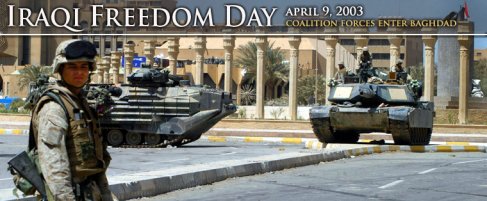
A leatherneck with 1st Marine Division mans a post in the streets in the center of Baghdad, April 11, 2003. First Marine Division and other elements of the Marine Expeditionary Force secured the capital city less than three weeks into Operation Iraqi Freedom. U.S. Marine Corps photo by Sgt. Joseph R. Chenelly
Three Years After Baghdad’s Fall, Troops Note Progress
Three years ago April 9, the world looked on, captivated by compelling television images of Iraqis ripping down a towering statue of Saddam Hussein in Baghdad, and burning images of the Iraqi dictator on the streets.

The statue of Saddam Hussein topples in Baghdad’s Firdos Square on April 9, 2003. Three years later, Iraqi forces increasingly are taking the lead in securing their country.
Defense Secretary Donald Rumsfeld lauded it as an important sign of things to come. “We’re seeing history unfold and events that will shape the course of a country, the fate of a people and potentially the future of the region,” Rumsfeld said during an April 9, 2003, Pentagon press briefing. “Saddam Hussein is now taking his rightful place alongside (Adolf) Hitler, (Joseph) Stalin, (Vladimir) Lenin and (Nicholae) Ceausescu in the pantheon of failed brutal dictators.
“And the Iraqi people are well on their way to freedom,” he said.
The toppling of Saddam’s statue in Baghdad’s Firdos Square was just one — but perhaps the most symbolic — part of the city’s fall from the grip of the brutal dictator who had ruled it with an iron fist for more than three decades. Days earlier, coalition troops captured the city’s airport, named after Saddam, and renamed it Baghdad International Airport. They also took the Presidential Palace in downtown Baghdad and began moving freely through the city.
Eight months after his larger-than-life image was pulled from its podium in downtown Baghdad, Saddam was pulled from a “spider hole” near his hometown of Tikrit on Dec. 13. About 600 members of the 1st Brigade, 4th Infantry Division, along with special operations forces, captured him after receiving intelligence that the former dictator was in the area.
Saddam is now standing trial on charges of war crimes and crimes against humanity.
Three years later, as the anniversary of Baghdad’s fall is commemorated as “Iraqi Freedom Day,” troops serving in Iraq say they’re proud of what it paved the way for throughout the country.
Army Lt. Col. Thomas Murphree, who was serving in Kuwait at the time as theater distribution commander, said seeing images of Iraqis pulling down Saddam’s statue in Baghdad assured him:
“They didn’t like him or his regime.” “We did the right thing then, and we’re still doing the right thing,” said Murphree, who returned to Camp Victory, Iraq, in January as deputy transportation officer for Multinational Corps Iraq.
Army Sgt. Maj. Linda Allen, remembers the shock she experienced rolling into Iraq from Kuwait in late April. “I remember how devastating it was coming up to Iraq and running across the civilians,” she said. “They were hungry. They had no place to live and no water to drink. Every child we passed was motioning to their mouth because they were hungry.”
The soldiers say they’re witnessing evidence of that better life throughout the country. “You see a lot of new buildings going up and police stations being built and improvements in the health-care system,” said McCoy.
“It’s getting better day by day,” agreed Murphree. “But it doesn’t all happen overnight.”
Since liberating Iraq, the United States has helped the Iraqis build or repair aging sewage treatment plans for 5.1 million Iraqis and funded projects that have improved access to clean water for 3.1 million people.
These infrastructure improvements are important to assuring that Iraqis have the basics that Americans take for granted – “a job, the ability to take care of their families and have a roof over their head and a safe place to live,” Murphree said. And he said it’s also a critical component to establishing a new, democratic government in Iraq.
“There’s still a ton of work to do, and we’re not leaving anytime soon,” she said. “But there’s a lot of progress and it’s a whole lot better than it was three years ago.”
 Thank you to everyone in our military!
Thank you to everyone in our military!
